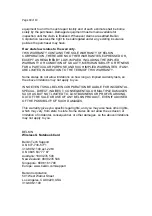
Page 35 of 40
You need to disable the built-in wireless card from your computer under “Network
Adapters” in the Device Manager.
Card does not perform or connection is slow when computer has a built-in
wired Ethernet card.
This condition occurs if your computer has an active Ethernet card while your
Wireless Card is also active. This happens because Windows must now handle
two active network connections. You need to disable the Ethernet card from your
computer under “Network Adapters” in the Device Manager.
What’s the difference between 802.11b, 802.11g, 802.11a, and Pre-N?
Currently there are four levels of wireless networking standards, which transmit
data at very different maximum speeds. Each is based on the designation for
certifying network standards. The most common wireless networking standard,
802.11b, transmits information at 11Mbps; 802.11a and 802.11g work at 54Mbps;
and Pre-N works at 108Mbps. Pre-N, the precursor to the upcoming 802.11n
release, promises speeds that exceed 802.11g, and up to twice the wireless
coverage area. See the following chart for more detailed information.
Wireless Comparison Chart
Wireless
Technology
802.11b
802.11g
802.11a
Belkin Pre-N
Speed
11Mbps 54Mbps 54Mbps 600%
faster
than
standard
802.11g*
Frequency
Common
household
devices such as
cordless phones
and microwave
ovens may
interfere with the
unlicensed band
2.4GHz
Common
household
devices such as
cordless phones
and microwave
ovens may
interfere with the
unlicensed band
2.4GHz
5GHz—
uncrowded band
Common
household
devices such as
cordless phones
and microwave
ovens may
interfere with the
unlicensed band
2.4GHz
Compatibility
Compatible with
802.11g
Compatible with
802.11b
Incompatible with
802.11b or
802.11g
Compatible with
802.11g or
802.11b
Coverage*
Depends on
interference—
typically 100–200
ft. indoors
Depends on
interference—
typically 100–200
ft. indoors
Interference
range is typically
50–100 ft.
Up to 800% wider
coverage than
standard
802.11g*
Advantage
Mature—legacy
technology
Common—
widespread use
for Internet
sharing
Less
interference—
great for
multimedia
Leading edge—
best coverage
and throughput




















